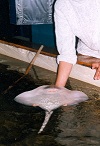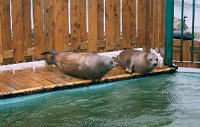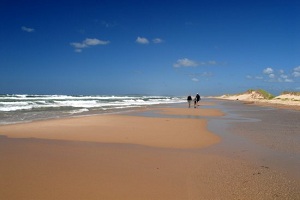 Situated in the heart of the Gulf of St. Lawrence is a small group of islands, Les Îles de la Madeleine, known in English as The Magdalen Islands. The L-shaped archipelago is the visible portion of an underwater plateau, a rocky, mountainous mass created by volcanic upheaval thousands of years ago. There are twelve islands, seven are inhabited and six of these are connected by long narrow white sand dunes, combining to create 300 km of the most beautiful beaches in all of Canada. In the sunlight the red cliffs are spectacular. Centuries of working closely with nature has resulted in the sea creating the perfect sanctuary for her offspring and a haven for the many birds that use the islands as a stepping stone on migratory routes. Over time parallel sand dunes have formed and in trapping both fresh and sea water between them have created lagoons, the perfect incubator for marine life, sea birds and water fowl.
Situated in the heart of the Gulf of St. Lawrence is a small group of islands, Les Îles de la Madeleine, known in English as The Magdalen Islands. The L-shaped archipelago is the visible portion of an underwater plateau, a rocky, mountainous mass created by volcanic upheaval thousands of years ago. There are twelve islands, seven are inhabited and six of these are connected by long narrow white sand dunes, combining to create 300 km of the most beautiful beaches in all of Canada. In the sunlight the red cliffs are spectacular. Centuries of working closely with nature has resulted in the sea creating the perfect sanctuary for her offspring and a haven for the many birds that use the islands as a stepping stone on migratory routes. Over time parallel sand dunes have formed and in trapping both fresh and sea water between them have created lagoons, the perfect incubator for marine life, sea birds and water fowl.
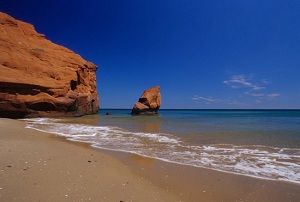
© Le Québec maritime / Michel Bonato
For the back to nature enthusiast, this is paradise: the winds, wide stretches of beach, inner lagoons and waters of the Gulf attract visitors who want to dive, swim, sail, fish, canoe, kayak, windsurf, fly kites and even build sandcastles. Isolated from the rest of Canada, their language has evolved from a unique mix of English and French, from Irish and Scottish shipwreck victims, native Micmac hunters, French and British colonists and, most notably, Acadians escaping deportation. Today the islands are part of Québec and happily back in the hands of the Madelinots.
This is a part of Canada to which I will return. My first visit was in the early summer exploring the islands and tackling the Big Hill on Île d’Entrée; my second, the winter seal excursion, an experience that rates with travelling to photograph the polar bears in northern Manitoba.
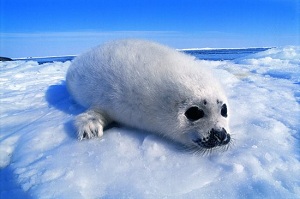
© Le Québec maritime / Jean-Pierre Sylvestre
I was lucky enough to be able to stay out on the ice floes overnight: though sleeping in the confines of an ice-breaker with seven other photographers, most of whom snored, is not generally available nor something I would recommend to the average tourist. The photographers had come from all over the world and were rising early to catch the dawn light, working all day and then out again for magical sunsets resulting in some fantastic images for their magazines.
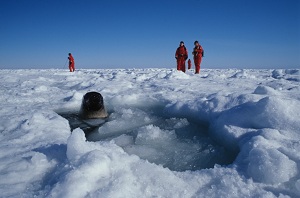
Credit: M.Bonato
I’d love to think that all this is helping to build a relatively new industry for the Madelinots with tourism replacing some of their need to rely on fishing and the controversial harvesting of seals.
Although relatively isolated, there is always something to do in the Magdalen Islands, rain or shine, summer and winter. Interesting museums and cafes, incredible restaurants, wonderful sports, and smaller islands dedicated to wildlife and offering bird-watchers amazing opportunities. The Madelinots are inventive and have created unique crafts and businesses that maximize on their resources. Following are three that captured my imagination but there are more listed in the travel tips that accompany the episode information for our three video features (1) Culture and cuisine (2) The seal excursion and (3) Adventures with wind and water.
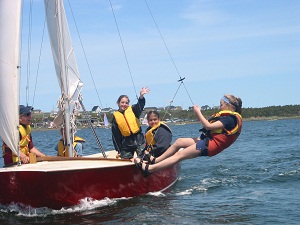
Credit: L'Istorlet
A sea of adventures: For children aged 7-14, L’Istorlet is the perfect summer sailing camp. “It’s like sleeping in the open” said one enthusiast. Individual partly-closed bunks are tucked under a sloping roof with skylights to the stars. Each unit has its’ own drawer space, light and shelves. In the bathroom there’s a line of showers and individual sections for each child’s towel, soap and shampoo. “Children want to be treated as adults and yet they still want something different, fun and exciting” said Rita Castonguay. She and partner Alain Arsenault run L’Istorlet from May to September. “We have one qualified sailing instructor for every five to six students. All are CPR trained and each child has their own life jacket.
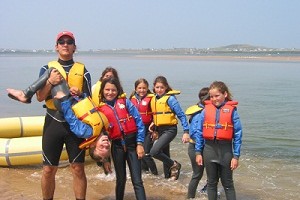
Credit: L'istorlet
The great thing about this area is that the bay is shallow, there are no currents and the water is warm, so it’s ideal for them to learn how to sail or canoe.” Subject to age, youngsters can participate in snorkelling, campfires, bicycling, bird watching, windsurfing, French immersion, a musical camp and theatre. For teenagers there’s a sea kayaking expedition where they camp in the wilderness and discover the cliffs, caves and seal colonies of the islands.
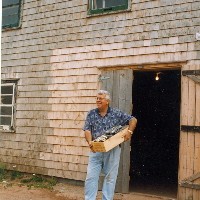 Le Fumoir D’Antan: “The herring was once so numerous in these waters that people used to shovel the eggs from the beaches onto their gardens for fertilizer” recounted Benoit Arsenault. “Herring was our main industry and destroyed through overfishing”. Arsenault started his herring smoke house in Havre-Maison partly as a tourist attraction and also to preserve a tradition. The herring are salted for 48 hours,
Le Fumoir D’Antan: “The herring was once so numerous in these waters that people used to shovel the eggs from the beaches onto their gardens for fertilizer” recounted Benoit Arsenault. “Herring was our main industry and destroyed through overfishing”. Arsenault started his herring smoke house in Havre-Maison partly as a tourist attraction and also to preserve a tradition. The herring are salted for 48 hours, 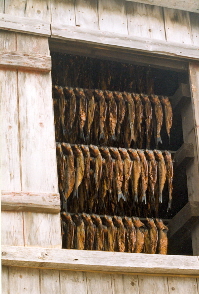 then put on sticks and hung in the smoke shack to dry for up to 90 days. There is no waste, each fish yields 2 filets, the eggs are packaged as caviar and the rest is used for fertilizer — vitally important for islands built almost entirely on sand.
then put on sticks and hung in the smoke shack to dry for up to 90 days. There is no waste, each fish yields 2 filets, the eggs are packaged as caviar and the rest is used for fertilizer — vitally important for islands built almost entirely on sand.
“It’s rapidly becoming a business again but we are taking care to limit the catches.” And who limits the catches? “I did” laughed Arsenault “When I was Mayor.”
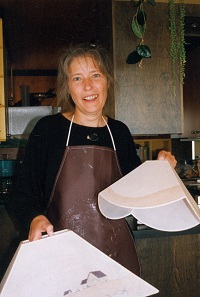 Lady of the lamps: With all that sand around, you can bet it wasn’t too long before the creative ingenuity of a Madelinot took control. Some years ago in her workshop above Les Artisans du Sable, the store that she owned with her husband Albert Cummings in Havre-Aubert, Nicole Grégoire showed me an amazing collection of coloured sand. “This red is from Île Brion” she explained “it is one of the Madeleine Islands, but now it is strictly a wildlife sanctuary. The orange sand I found in Utah and the blue from Arizona.” Nicole has trays of sand that she has collected from all across North America. They shade from white to pink to coral and even black. Under her microscope, sand from Japan is revealed as tiny perfect stars. She also started collecting tiny coloured stones and miniature shells. And what did she do with it all? She made lampshades.
Lady of the lamps: With all that sand around, you can bet it wasn’t too long before the creative ingenuity of a Madelinot took control. Some years ago in her workshop above Les Artisans du Sable, the store that she owned with her husband Albert Cummings in Havre-Aubert, Nicole Grégoire showed me an amazing collection of coloured sand. “This red is from Île Brion” she explained “it is one of the Madeleine Islands, but now it is strictly a wildlife sanctuary. The orange sand I found in Utah and the blue from Arizona.” Nicole has trays of sand that she has collected from all across North America. They shade from white to pink to coral and even black. Under her microscope, sand from Japan is revealed as tiny perfect stars. She also started collecting tiny coloured stones and miniature shells. And what did she do with it all? She made lampshades.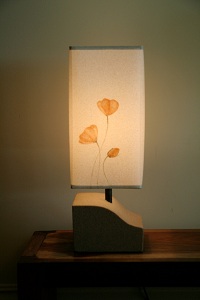
With infinite patience, Nicole took a wire frame, carefully attached a thin layer of tissue paper to each section, and then painted the tissue with acrylic. After leaving it to dry for several hours she would add more tissue and repeat the process four times. She drew in her designs with glue and then carefully added the sand by hand. It is a slow painstaking process. “I destroyed so many in the beginning” she said “one mistake and it is ruined”. The idea came to her over 26 years ago and people rarely visit the island without buying one of her lampshades as a souvenir.
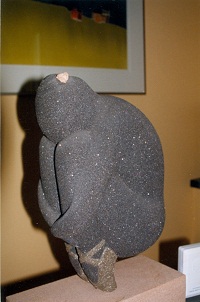 At the same time, downstairs, I met Albert who explained that they have artisans who work primarily in the winter and create sand sculptures. After mixing sand with a resin in large containers, they let them sit for 3 days until “they are solid like a rock” he told me “then we work with it as if it was wood, turn it on a lathe and carve it with old files”. The results are magnificent sculptures, pots, vases, tables and even a chess set. Artisans du Sable is a proud member of Economuseum network. Nicole and Albert have now passed the torch to the younger generation and daughter, Pauline-Gervaise Grégoire, is running the business while Albert occasionally gives workshops in the sand box to aspiring artisans du sable.
At the same time, downstairs, I met Albert who explained that they have artisans who work primarily in the winter and create sand sculptures. After mixing sand with a resin in large containers, they let them sit for 3 days until “they are solid like a rock” he told me “then we work with it as if it was wood, turn it on a lathe and carve it with old files”. The results are magnificent sculptures, pots, vases, tables and even a chess set. Artisans du Sable is a proud member of Economuseum network. Nicole and Albert have now passed the torch to the younger generation and daughter, Pauline-Gervaise Grégoire, is running the business while Albert occasionally gives workshops in the sand box to aspiring artisans du sable. 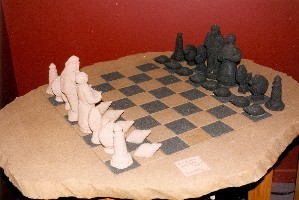 They still create lampshades, wonderful sculptures, and my favourite, a chess set.
They still create lampshades, wonderful sculptures, and my favourite, a chess set.
Travel Tips: For more things to see and do on Les Îles de la Madeleine check out Episodes 8, 9 and 10 in the information section for Railway Adventures across Canada.
